Silas Condict was an American farmer, prominent surveyor, and large landowner from Morris County, New Jersey. He served as a New Jersey delegate to the Continental Congress from 1781 to 1783. Later, he served a number of terms in the State Assembly, and was its Speaker in 1792-1794 and in 1797. His name can be found in archived Congressional records @ " A Biographical Congressional Directory, 1774-1903" @ page 467, found at Google books and at Archive.org. It is found here also:, one of many Congressional Archive sources showing the Condict family.
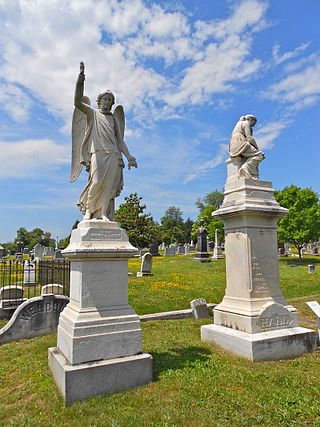
The Congressional Cemetery, officially Washington Parish Burial Ground, is a historic and active cemetery located at 1801 E Street, S.E., in Washington, D.C., on the west bank of the Anacostia River. It is the only American "cemetery of national memory" founded before the Civil War. Over 65,000 individuals are buried or memorialized at the cemetery, including many who helped form the nation and Washington, D.C. in the early 19th century.

Fairmount Cemetery is a 150-acre (0.61 km2) rural cemetery in the West Ward of Newark, New Jersey, in the neighborhood of Fairmount. It opened in 1855, shortly after the Newark City Council banned burials in the central city due to fears that bodies spread yellow fever. The first burial in Fairmount Cemetery was a 24-year-old man named Lewis J. Pierson. Fairmount is still accepting interments.

Mount Olivet Cemetery is a historic rural cemetery located at 1300 Bladensburg Road, NE in Washington, D.C. It is maintained by the Roman Catholic Archdiocese of Washington. The largest Catholic burial ground in the District of Columbia, it was one of the first in the city to be racially integrated.

Holy Name Cemetery is a Roman Catholic cemetery in Jersey City, New Jersey administered by the Roman Catholic Archdiocese of Newark. It was established in 1866 and at the end of calendar year 2002 has accepted 264,984 burials. The cemetery parcel is 63 acres (250,000 m2) and all but 0.3 acres (1,200 m2) has been developed and sold for burials. It is an active cemetery providing services to Catholic families.

John Cornelius Butler was a Republican politician from New York. He was most notable for his service as a member of the United States House of Representatives from 1941 to 1949 and 1951 to 1953.
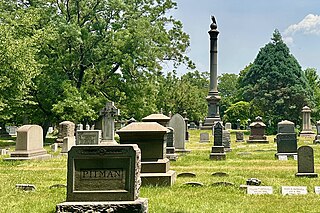
Riverview Cemetery is a historic cemetery located at 870 Centre Street in the city of Trenton, New Jersey in Mercer County, New Jersey, United States. A number of notables are interred there, including Civil War Union Army Major General and New Jersey Governor George B. McClellan, whose grave is marked by the tallest monument in the cemetery. His wife, Mary Ellen Marcy McClellan, is interred with him.

Charles Averill Barlow was an American farmer, businessman and politician. He was most notable for his service as a member of the California State Assembly and a member of the U.S. representative from California's 6th congressional district.
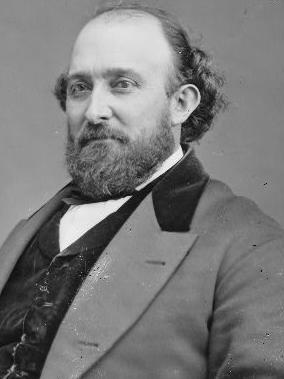
Green Berry Raum was a lawyer, author, and U.S. Representative from Illinois, as well as a brigadier general in the Union Army during the American Civil War. He served in the Western Theater, seeing action in several major battles while leading first an infantry regiment and then a brigade. He also presided over the Internal Revenue Service for seven years and was a prolific author of historical non-fiction books concerning politics and general Illinois history.

Amasa Dana was an American lawyer and politician who served two non-consecutive terms as a U.S. Representative from New York from 1839 to 1841, and from 1843 to 1845.

First Dutch Reformed Church, also known as the "Old Church on the Green", is located in Hackensack, New Jersey.

The Old First Presbyterian Church, also known as First Presbyterian Church and Cemetery, is a church in Newark, Essex County, New Jersey, United States. The church was listed on the National Register of Historic Places in 1972. The grounds, located in the Four Corners Historic District, includes an old burial ground.

Oakwood Cemetery is a nonsectarian rural cemetery in northeastern Troy, New York, United States. It operates under the direction of the Troy Cemetery Association, a non-profit board of directors that deals strictly with the operation of the cemetery. It was established in 1848 in response to the growing rural cemetery movement in New England and went into service in 1850. The cemetery was designed by architect John C. Sidney and underwent its greatest development in the late 19th century under superintendent John Boetcher, who incorporated rare foliage and a clear landscape design strategy. Oakwood was the fourth rural cemetery opened in New York and its governing body was the first rural cemetery association created in the state.

Old Broad Street Presbyterian Church and Cemetery is a historic church on Broad and Lawrence Streets in Bridgeton, Cumberland County, New Jersey, United States. It was built in 1792 and added to the National Register of Historic Places in 1974. The church and cemetery are also listed on both the New Jersey Register
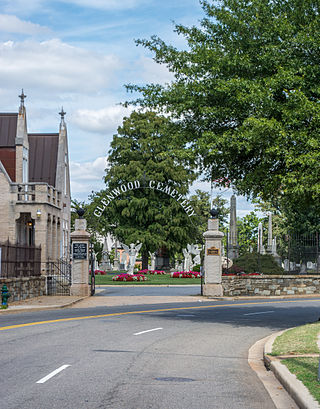
Glenwood Cemetery is a historic cemetery located at 2219 Lincoln Road NE in Washington, D.C. It is a private, secular cemetery owned and operated by The Glenwood Cemetery, Inc. Many famous people are buried in Glenwood Cemetery, and the cemetery is noted for its numerous elaborate Victorian and Art Nouveau funerary monuments. The cemetery was listed on the National Register of Historic Places in 2017; its mortuary chapel was separately listed in 1989.
Arlington Ridge Road is a street through residential areas and business districts in Arlington County, Virginia in the United States. South Arlington Ridge Road is roughly 1.5 miles in length and extends from Prospect Hill Park/Army-Navy Drive in the north to Glebe Road and Four Mile Run creek in the south. As it crosses the creek it turns into Mount Vernon Avenue. Arlington Ridge Road was first constructed in 1840, and formerly extended north through Arlington National Cemetery to Rosslyn, Virginia near Francis Scott Key Bridge and the Potomac River.

The McClellan Gate is a memorial to Major General George B. McClellan located inside Arlington National Cemetery in Arlington County, Virginia, in the United States. Constructed about 1871 on Arlington Ridge Road, it served as a main gate until about 1879 when the Sheridan Gate was constructed. The McClellan Gate became nonfunctional in 1966 when the road closed, and expansion of the cemetery eastward in 1971 left the gate deep inside Arlington. It is the only gate constructed on the cemetery's eastern boundary in the 1800s that survives.

Gate of Heaven Cemetery is a cemetery located in the Aspen Hill section of Silver Spring, Maryland, in the United States. It is operated and maintained by the Catholic Cemeteries of the Archdiocese of Washington, Inc. At the time of the cemetery's consecration in 1956, it was the first Roman Catholic archdiocesan cemetery to open in the Washington metropolitan area in 70 years. The grounds of Gate of Heaven Cemetery are centered around a series of internal roads and pathways, which in combination, form the shape of the Latin Cross.
Holmead's Burying Ground, also known as Holmead's Cemetery and the Western Burial Ground, was a historic 2.94-acre (11,900 m2) cemetery located in the Dupont Circle neighborhood of Washington, D.C., in the United States. It was founded by Anthony Holmead in 1794 as a privately owned secular cemetery open to the public. The city of Washington, D.C., constructed the Western Burial Ground on the remainder of the city block in 1798, and the two burial grounds became synonymous. The city took ownership of the private Holmead cemetery in 1820. The unified cemetery went into steep decline around 1850, and it was closed on March 6, 1874. Removal of remains, most of which were reinterred at Graceland Cemetery or Rock Creek Cemetery, continued until 1885.
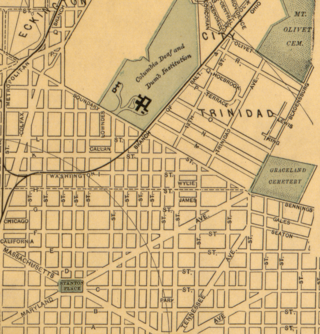
Graceland Cemetery was a 30-acre (120,000 m2) cemetery located in the Carver Langston neighborhood of Washington, D.C., in the United States. It was founded in 1871 as a privately owned secular cemetery open to the public, but it primarily served the city's African American community. From 1884 to 1885, more than 1,200 bodies were transferred to Graceland Cemetery from Holmead's Burying Ground. When the cemetery encountered financial problems, the owners attempted to sell the land. This led to a lengthy and bitter battle involving the Graceland Cemetery Association, lot holders, the government of the District of Columbia, and the United States Congress. Graceland Cemetery was closed by an Act of Congress on August 3, 1894. Removal of remains was also bitterly contested, but a court ruled in the summer of 1895 that the lot holders did not have the right to prevent their removal. Most of the bodies at Graceland were reinterred at Woodlawn Cemetery in Washington, D.C.



















